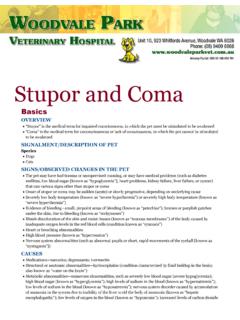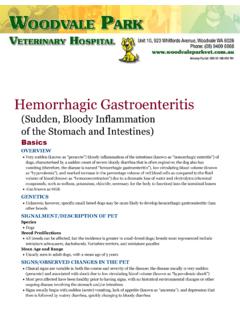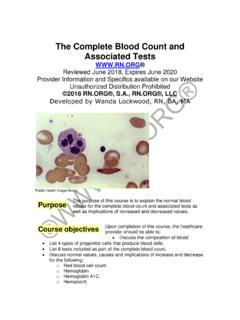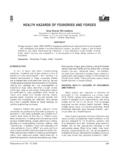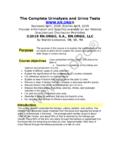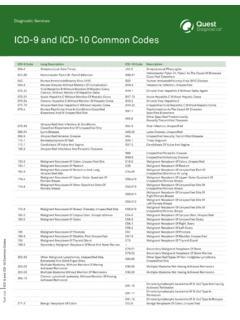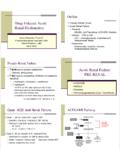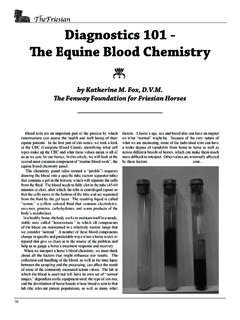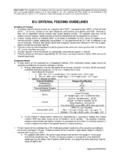Transcription of Chronic Diarrhea in Dogs - Woodvale Park Veterinary Hospital
1 Chronic Diarrhea in Dogs Basics OVERVIEW A change in the frequency, consistency, and volume of bowel movement (feces) for more than 3 weeks Can be either small bowel (small intestine) Diarrhea , large bowel (large intestine or colon) Diarrhea , or mixedsmall and large bowel diarrheaSIGNALMENT/DESCRIPTION OF PET Species DogsSIGNS/OBSERVED CHANGES IN THE PET Underlying disease process determines clinical signsSmall Bowel Diarrhea (Involves the Small Intestines) Larger volume of bowel movement (feces) than normal Frequency of defecation is mild to moderately above normal (2 4 times per day) Weight loss Increased appetite (known as polyphagia ) in cases with abnormal digestion or absorption of food (known as maldigestion or malabsorption, respectively) May have black, tarry stools (due to the presence of digested blood; condition known as melena ).
2 No mucus orred blood in the bowel movement (presence of red blood in the bowel movement known as hematochezia ) Little to no evidence of painful defecation or straining to defecate (known as tenesmus ) or difficulty indefecating (known as dyschezia ) May have excessive gas formation in the stomach or intestines (known as flatulence ) and rumbling or gurglingsounds caused by movement of gas in the intestinal tract (known as borborygmus ) Vomiting in some dogs Poor body condition with some causes of long-term ( Chronic ) Diarrhea Dehydration variable Thickened intestines, abdominal fluid, and enlarged abdominal lymph nodes may be felt by your pet'sveterinarian Large Bowel Diarrhea (Involves the Large Intestines or Colon) Smaller volume of bowel movement (feces) per defecation than normal Frequency of defecation significantly higher than normal (greater than 4 times per day) No weight loss Often mucus or red blood in the bowel movement (hematochezia).
3 No evidence of black, tarry stools (melena) Painful defecation or straining to defecate (tenesmus) and urgency to defecate Difficulty defecating (dyschezia) with rectal or lower colonic disease Excessive gas formation in the stomach or intestines (flatulence) and rumbling or gurgling sounds caused by movement of gas in the intestinal tract (borborygmus) is variable Vomiting in some dogs Body condition more typically normal Dehydration uncommon Thickened intestines may be felt by your pet's veterinarian CAUSES Small Bowel Diarrhea (Involves the Small Intestines) Primary Small Intestinal Disease Inflammatory bowel disease various types, including lymphoplasmacytic enteritis, granulomatous enteritis, eosinophilic enteritis, immunoproliferative enteropathy of basenjis, and sprue Dilation of the lymphatic vessels (known as lymphangiectasia )
4 Tumor or cancer such as lymphoma or adenocarcinoma Parasites Giardia, roundworms (Toxocara), hookworms (Ancylostoma), and Strongyloides Bacterial infection Campylobacter, Salmonella, Escherichia coli, Clostridium perfringens, Yersinia Viral infection coronavirus, parvovirus, canine distemper virus, rotavirus Fungal disease histoplasmosis and aspergillosis Pythiosis (infection with Pythium, a water mold) Partial blockage or obstruction foreign body; folding of one segment of the intestine into another segment (known as intussusception ); and cancer Condition in which a high number of bacteria are found in the upper small intestine (known as small intestinal bacterial overgrowth ) Diarrhea and other signs caused by absence of a long section of small intestine, usually because of surgical removal (condition known as short-bowel syndrome ) Ulcers of the stomach and upper intestines (known as gastroduodenal ulcers ) Abnormal Digestion of Food (Maldigestion)
5 Syndrome caused by inadequate production and secretion of digestive enzymes by the pancreas (known as exocrine pancreatic insufficiency ) Liver disease Diet Dietary intolerance or allergy Gluten-sensitive enteropathy in Irish setters Rapid change in diet Metabolic Disorders Liver disease; decreased levels of steroids produced by the adrenal glands (known as hypoadrenocorticism or Addison's disease ); excess levels of urea and other nitrogenous waste products in the blood (known as uremia ) Other Poisons Side effect of medications Large Bowel Diarrhea (Involves the Large Intestines or Colon) Primary Large Intestinal Disease Inflammatory bowel disease various types, including lymphoplasmacytic colitis, eosinophilic colitis, histiocytic ulcerative colitis, and granulomatous colitis Tumor or cancer such as benign polyp, lymphoma, adenocarcinoma, leiomyoma, and leiomyosarcoma Parasites whipworms (Trichuris), Giardia, hookworms (Ancylostoma)
6 , Entamoeba, and Balantidium Bacterial infections Campylobacter, Salmonella, and Clostridium perfringens Fungal disease histoplasmosis Pythiosis (infection with Pythium, a water mold) Infection with algae Prototheca Non-inflammatory causes (such as folding of one segment of the intestine [the ileum, or lower small intestine] into another segment [the colon]; condition known as an ileocolic intussusception ) Diet Diet dietary indiscretion (that is, eating substances that should not be eaten), diet changes, and foreign material (such as bones and hair) Fiber Metabolic Disorders Excess levels of urea and other nitrogenous waste products in the blood (uremia) Decreased levels of steroids produced by the adrenal glands (hypoadrenocorticism or Addison's disease) Other Unknown cause (so-called idiopathic disease ) irritable bowel syndrome RISK FACTORS Small Bowel Diarrhea (Involves the Small Intestines)
7 Dietary changes and feeding poorly digestible or high-fat diets Large-breed dogs, especially German shepherd dogs, have the highest incidence of exocrine pancreatic insufficiency (syndrome caused by inadequate production and secretion of digestive enzymes by the pancreas) Pythiosis (infection with Pythium, a water mold) occurs most often in young, large-breed dogs living in states bordering the Gulf of Mexico Large Bowel Diarrhea (Involves the Large Intestines or Colon) Dietary changes or indiscretion, stress, and psychological factors Histiocytic ulcerative colitis (inflammation characterized by a thickened lining of the colon with varying degrees of loss of the superficial lining [known as ulceration ].)
8 The thickening is due to infiltration of various cells [histiocytes, plasma cells, and lymphocytes] in the layers under the lining) occurs most often in boxers less than 3 years of age Pythiosis (infection with Pythium, a water mold) occurs most often in young, large-breed dogs living in states bordering the Gulf of Mexico Treatment HEALTH CARE Treat the underlying cause symptomatic treatment rarely resolves long-term ( Chronic ) Diarrhea Fecal examinations to identify parasites are often negative in whipworm-infested dogs because of intermittent shedding of eggs; because whipworms are a common cause of Diarrhea , deworming with fenbendazole may be performed as a diagnostic aid before pursuing extensive diagnostic tests Fluid therapy, if pet is dehydrated Consider colloids for pets with low levels of protein in the blood (known as hypoproteinemia ) that need fluid therapy.
9 Colloids are fluids that contain larger molecules that stay within the circulating blood to help maintain circulating blood volume, examples are dextran and hetastarch Correct electrolyte (such as sodium, potassium, chloride) and acid base imbalances Some dogs with inflammatory bowel disease or exocrine pancreatic insufficiency (syndrome caused by inadequate production and secretion of digestive enzymes by the pancreas) have secondary small intestinal bacterial overgrowth (condition in which a high number of bacteria are found in the upper small intestine)
10 , which must be treated along with the primary disorder DIET Feeding a low-fat, highly digestible diet for 3 4 weeks may resolve Diarrhea due to dietary intolerance Feeding a hypoallergenic diet may be beneficial, if food allergy is suspected SURGERY Biopsy of the stomach, small intestine, and/or large intestine Exploratory surgery of the abdomen and surgical biopsy Medications Medications presented in this section are intended to provide general information about possible treatment. The treatment for a particular condition may evolve as medical advances are made; therefore, the medications should not be considered as all inclusive Medications var
